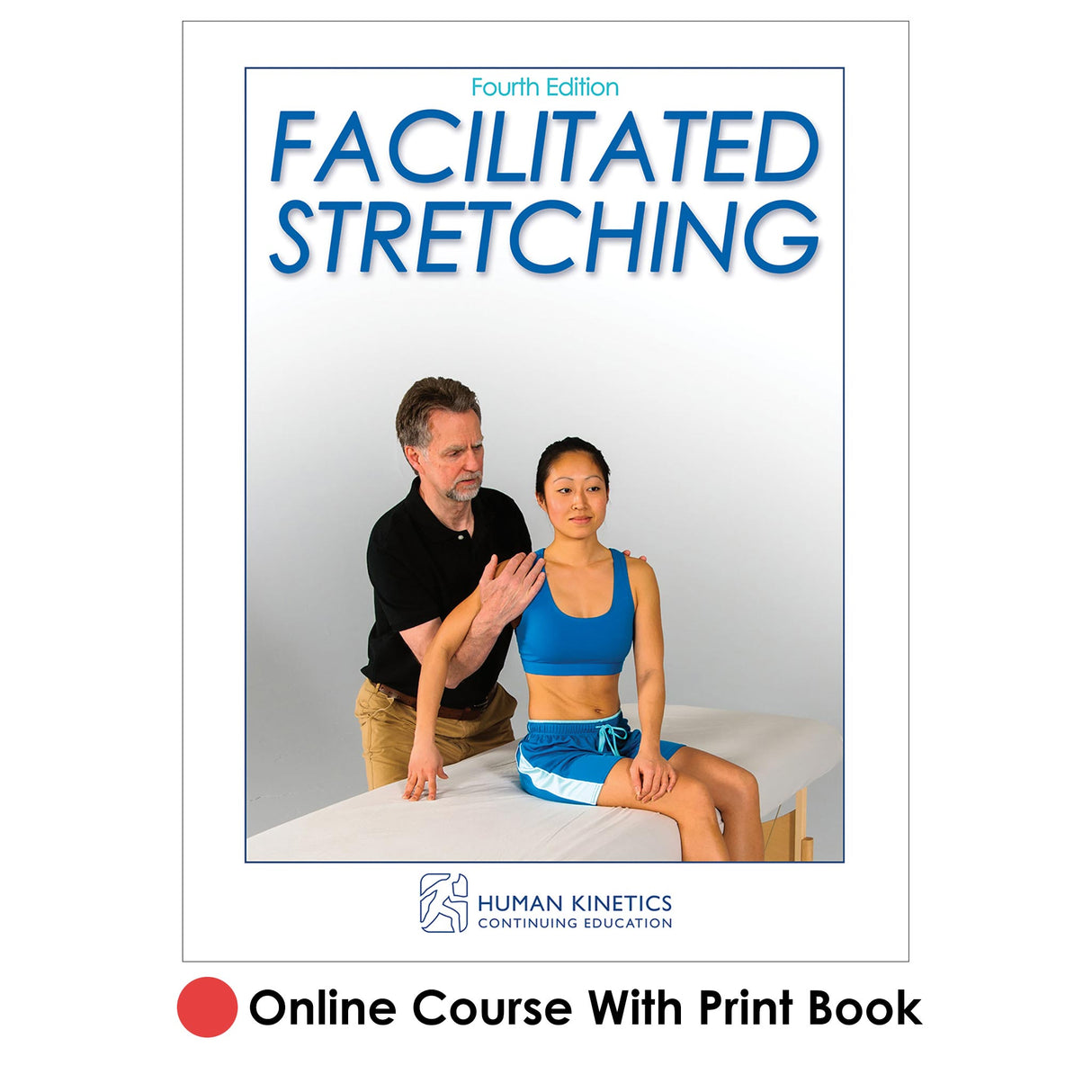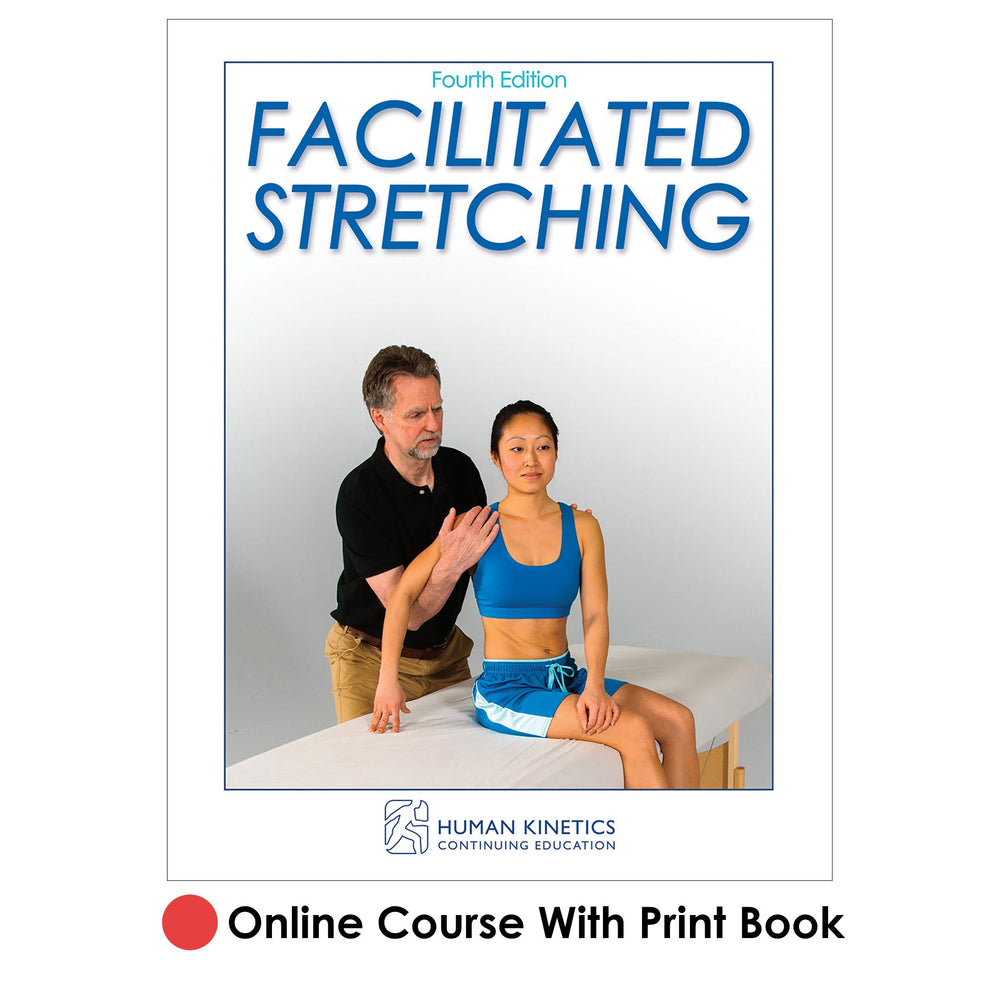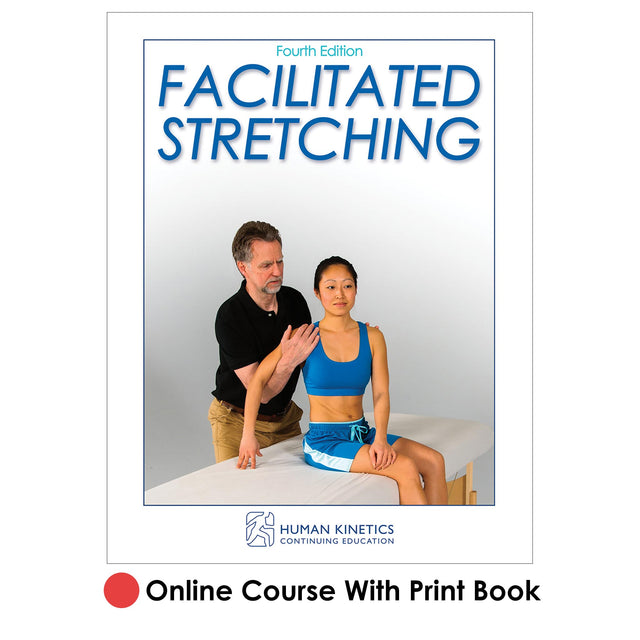Facilitated Stretching 4th Edition Online CE Course With Print Book
Author: Human Kinetics
$125.00 USD
Unit price
/
Unavailable
Online Course With Print Book
$125.00 USD
$125.00 USD
This package includes the following:
The book’s full-color interior presents more than 450 photos and illustrations visually depicting the techniques being discussed. A majority of the stretches include a self-stretch version and a partner stretch, with graphic elements on select photos highlighting the isometric effort for the stretcher and the partner. Stretches are grouped according to joint and are demonstrated in a variety of settings, including a treatment table, mat on the floor, chair, cable-pulley machine, and weightlifting bench.
The accompanying online video demonstrates more than 90 of the stretches in the book, to reinforce proper technique for each stretch, as well as four sample stretching routines. The book also includes specific routines for athletes in cycling, golf, running, swimming, throwing and racket sports, and ice hockey. An appendix showcases anatomical planes of motion, anatomical terms, and types of joints to help professionals understand the body and how the material can be used in helping athletes.
The included recorded webinar by book author and expert Robert McAtee, LMT, CSCS, C-PT, offers further application of the foundational aspects of facilitated stretching. The study guide offers a series of questions on over 90 stretches to help further understanding. Once you complete the course and pass the exam, you can print a certificate for continuing education credits.
Learning Objectives
- Facilitated Stretching, Fourth Edition, book
- Online video
- Online study guide
- Recorded webinar
- Online continuing education exam
The book’s full-color interior presents more than 450 photos and illustrations visually depicting the techniques being discussed. A majority of the stretches include a self-stretch version and a partner stretch, with graphic elements on select photos highlighting the isometric effort for the stretcher and the partner. Stretches are grouped according to joint and are demonstrated in a variety of settings, including a treatment table, mat on the floor, chair, cable-pulley machine, and weightlifting bench.
The accompanying online video demonstrates more than 90 of the stretches in the book, to reinforce proper technique for each stretch, as well as four sample stretching routines. The book also includes specific routines for athletes in cycling, golf, running, swimming, throwing and racket sports, and ice hockey. An appendix showcases anatomical planes of motion, anatomical terms, and types of joints to help professionals understand the body and how the material can be used in helping athletes.
The included recorded webinar by book author and expert Robert McAtee, LMT, CSCS, C-PT, offers further application of the foundational aspects of facilitated stretching. The study guide offers a series of questions on over 90 stretches to help further understanding. Once you complete the course and pass the exam, you can print a certificate for continuing education credits.
Learning Objectives
- Discuss general guidelines for any type of stretching, including the importance of good biomechanics.
- Examine the role of reflexes in stretching.
- Describe a variety of stretching techniques.
- Outline the spiral–diagonal patterns of PNF and describe how to use them in facilitated stretching to improve flexibility and the interaction of synergistic muscle groups.
- Explain and demonstrate strength training exercises using spiral patterns, incorporating stability balls and elastic bands.
- Explain and demonstrate how to stretch the major muscles, both partner-assisted and self-stretches for the upper extremities, lower extremities, neck, and torso.
- Create stretching routines for a variety of activities, including running, throwing and racket sports, cycling, golf, and swimming.
Audience
Sports medicine and fitness professionals, including massage and manual therapists, athletic trainers, personal trainers, and coaches.
Part I. The Prerequisites
Chapter 1. Understanding the Basics of Stretching
Soft Tissues Affected by Stretching
Muscle Interactions
Muscle Contractions
Reflexes Relevant to Facilitated Stretching
Types of Stretching
Guidelines for Stretching
Chapter Summary
Chapter 2. Focusing on Facilitated Stretching
PNF History
PNF Basis: Spiral–Diagonal Movement
PNF Stretching Techniques
Facilitated Stretching Guidelines
Detailed Sequence for Facilitated Stretching
Safety Considerations for Facilitated Stretching
Chapter Summary
Chapter 3. Using the Spiral–Diagonal Patterns of PNF
When and Why to Use Spiral-Pattern Stretches
Learning the Patterns Through Free Motion
Facilitated Stretching Using the Patterns
Lower Extremity Stretches Using the Patterns
Upper Extremity Stretches Using the Patterns
Strengthening Exercises Using the Patterns
Chapter Summary
Part II. The Stretches
Chapter 4. Stretches for the Torso and Neck
Oblique Abdominals
Lower Back
Upper Trapezius
Sternocleidomastoid
Scalenes
Suboccipitals
Levator Scapulae
Chapter 5. Stretches for the Lower Extremity
Hip Extensors
Hip Flexors
Hip Lateral (External) Rotators
Hip Medial (Internal) Rotators
Hip Abductors
Hip Adductors
Knee Extensors
Ankle Plantar Flexors
Ankle Dorsiflexors
Toe Flexors
Toe Extensors
Ankle Evertors: Peroneal (Fibularis) Group
Ankle Invertors
Chapter 6. Stretches for the Upper Extremity
Rotator Cuff
Scapular Stabilizers
Additional Muscles That Move the Arm
Elbow
Wrist and Hand
Supinators and Pronators
Chapter 7. Stretching Routines for Specific Activities
Everyday Sequence
Cycling
Golf
Ice Hockey
Running
Swimming
Throwing and Racket Sports
Rusty Hinges
Appendix. Anatomical Terms
Chapter 1. Understanding the Basics of Stretching
Soft Tissues Affected by Stretching
Muscle Interactions
Muscle Contractions
Reflexes Relevant to Facilitated Stretching
Types of Stretching
Guidelines for Stretching
Chapter Summary
Chapter 2. Focusing on Facilitated Stretching
PNF History
PNF Basis: Spiral–Diagonal Movement
PNF Stretching Techniques
Facilitated Stretching Guidelines
Detailed Sequence for Facilitated Stretching
Safety Considerations for Facilitated Stretching
Chapter Summary
Chapter 3. Using the Spiral–Diagonal Patterns of PNF
When and Why to Use Spiral-Pattern Stretches
Learning the Patterns Through Free Motion
Facilitated Stretching Using the Patterns
Lower Extremity Stretches Using the Patterns
Upper Extremity Stretches Using the Patterns
Strengthening Exercises Using the Patterns
Chapter Summary
Part II. The Stretches
Chapter 4. Stretches for the Torso and Neck
Oblique Abdominals
Lower Back
Upper Trapezius
Sternocleidomastoid
Scalenes
Suboccipitals
Levator Scapulae
Chapter 5. Stretches for the Lower Extremity
Hip Extensors
Hip Flexors
Hip Lateral (External) Rotators
Hip Medial (Internal) Rotators
Hip Abductors
Hip Adductors
Knee Extensors
Ankle Plantar Flexors
Ankle Dorsiflexors
Toe Flexors
Toe Extensors
Ankle Evertors: Peroneal (Fibularis) Group
Ankle Invertors
Chapter 6. Stretches for the Upper Extremity
Rotator Cuff
Scapular Stabilizers
Additional Muscles That Move the Arm
Elbow
Wrist and Hand
Supinators and Pronators
Chapter 7. Stretching Routines for Specific Activities
Everyday Sequence
Cycling
Golf
Ice Hockey
Running
Swimming
Throwing and Racket Sports
Rusty Hinges
Appendix. Anatomical Terms





